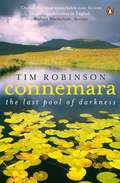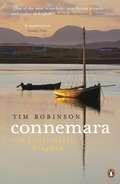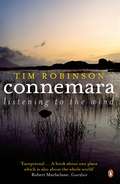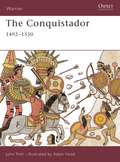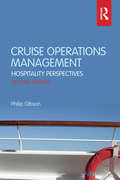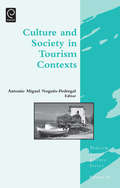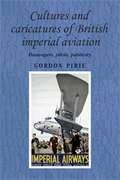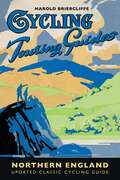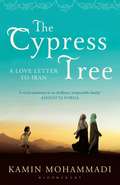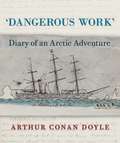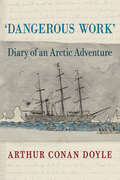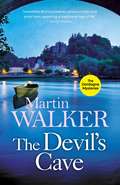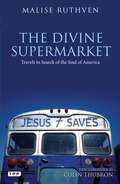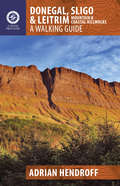- Table View
- List View
Connemara: The Last Pool of Darkness (Connemara Ser. #Bk. 1)
by Tim RobinsonThe second volume in Tim Robinson's phenomenal Connemara Trilogy - which Robert Macfarlane has called 'One of the most remarkable non-fiction projects undertaken in English'. The first volume of Tim Robinson's Connemara trilogy, Listening to the Wind, covered Robinson's home territory of Roundstone and environs. The Last Pool of Darkness moves into wilder territory: the fjords, cliffs, hills and islands of north-west Connemara, a place that Wittgenstein, who lived on his own in a cottage there for a time, called 'the last pool of darkness in Europe'. Again combining his polymathic knowledge of Connemara's natural history, human history, folklore and topography with his own unsurpassable artistry as a writer, Tim Robinson has produced another classic.A native of Yorkshire, Tim Robinson moved to the Aran Islands in 1972. His books include the celebrated two-volume Stones of Aran. Since 1984 he has lived in Roundstone, Connemara.'A masterpiece of travel and topographical writing and a miraculous, vivid and engrossing meditation on landscape and history and the sacred mood of places' Colm Tóibín, Irish Times
Connemara: A Little Gaelic Kingdom
by Tim RobinsonThe triumphant conclusion to Tim Robinson's extraordinary Connemara trilogy, which Robert Macfarlane has called 'one of the most remarkable non-fiction projects undertaken in English'. Robinson writes about the people, places and history of south Connemara - one of Ireland's last Gaelic-speaking enclaves - with the encyclopaedic knowledge of a cartographer and the grace of a born writer. From the man who has been praised in the highest terms by Joseph O'Connor ('One of contemporary Ireland's finest literary stylists''), John Burnside ('one of the finest of contemporary prose stylists'), Fintan O'Toole ('Simply one of the best non-fiction prose writers currently at work') and Giles Foden ('an indubitable classic'), among many others, this is one of the publishing events of 2011 and the conclusion of one of the great literary projects of our time.'He is that rarest of phenomena, a scientist and an artist, and his method is to combine scientific rigour with artistic reverie in a seamless blend that both informs and delights.' John Banville, Guardian'A masterpiece of travel and topographical writing, and an incomparable and enthralling meditation on times past ... This perfectly pitched work opens readers up to the world around them' Sunday Times'Anyone willing to get lost in this book will be left with indelible mental images of places they may never have visited but will now never forget' Dermot Bolger, Irish Mail on Sunday'Will endure into the far future ... He knows this world as no one else does, and writes about it with awe and love, but also with measured grace, an artist's eye and a scientist's sensibility' Colm Toibin, Sunday Business Post Books of the Year'Robinson is a marvel ... the supreme practitioner of geo-graphy, the writing of places' Fintan O'Toole, Observer Books of the Year
Connemara: Listening to the Wind (Connemara Ser. #Bk. 1)
by Tim RobinsonThe first volume in Tim Robinson's phenomenal Connemara Trilogy - which Robert Macfarlane has called 'One of the most remarkable non-fiction projects undertaken in English'. In its landscape, history and folklore, Connemara is a singular region: ill-defined geographically, and yet unmistakably a place apart from the rest of Ireland. Tim Robinson, who established himself as Ireland's most brilliant living non-fiction writer with the two-volume Stones of Aran, moved from Aran to Connemara nearly twenty years ago. This book is the result of his extraordinary engagement with the mountains, bogs and shorelines of the region, and with its folklore and its often terrible history: a work as beautiful and surprising as the place it attempts to describe.Chosen as a book of the year by Iain Sinclair, Robert Macfarlane and Colm Tóibín'Dazzling ... an indubitable classic' Giles Foden, Condé Nast Traveller'One of contemporary Ireland's finest literary stylists' Joseph O'Connor, Guardian
The Conquistador: 1492–1550 (Warrior #Vol.40)
by John Pohl Mr Adam HookMany accounts portray the conquest of the New World as a remarkable military achievement, with Cortés' vastly outnumbered but better armed Spaniards defeating hordes of superstitious savages. However, the reality of these events is far more complex and no less significant. The first Conquistadors who had sailed in search of prosperity, inspired by dreams of unlimited riches, soon became disillusioned and restless. With disease rampant, resources exhausted, and the Caribbean populations dwindling, they had little alternative but to find new territories and peoples to exploit. This title shows how, bolstered by influxes of war-hardened veterans from Europe and an army of over 30,000 allied Indian troops, they came to rely on and perfect what they knew best killing for profit, and without mercy.
Crazy River: A Plunge into Africa
by Richard GrantNo-one travels like the renowned writer-adventurer Richard Grant and, really, no-one should. Having narrowly escaped death at the hands of Mexican drug barons in Bandit Roads, he now plunges with his trademark recklessness and curiosity into Africa. Setting out to make the first descent of a previously unexplored river in Tanzania, he gets waylaid by thieves, whores and a degenerate former golf pro in Zanzibar, then crosses the Indian Ocean in a cargo dhow before the real adventure begins on the Malagarasi river. Travelling by raft, dodging bullets, hippos, lions and crocodiles, hacking through swamps and succumbing to fevers, Grant's gripping, illuminating and often hilarious book will thrill his devoted readers and bring him to an even broader audience.
Cruise Operations Management: Hospitality Perspectives
by Philip GibsonCruise Operations Management: Hospitality Perspectives provides a comprehensive and contextualized overview of hospitality services for the cruise industry. As well as providing a background to the cruise industry, it also looks deeper into the management issues providing a practical guide for both students and professionals alike. Since the first edition of this book, there have been many important developments in the industry and this new edition features revised chapters on: contemporary cruise operations cruise geography itinerary planning health, safety and security maritime issues and legislation. In addition, there is a new chapter on 'Cruise Management Resources' intended to be of benefit to research students. Cruise Operations Management presents a range of issues illustrated by a number of case studies that encourage the reader to examine the often complex circumstances that surround problems or events associated with cruise operations. The case studies are contemporary and are constructed from first hand research with a number of international cruise companies providing a real world insight into this industry. They include 'Roles and Responsibilities on a Cruise Ship', 'Customer Service Systems and Passenger Profiles' and 'Managing Food and Drink Operations Onboard'. Each case study is followed by questions that are intended to illuminate issues and stimulate discussion.The structure of the book is designed so the reader can either build knowledge cumulatively for an in-depth knowledge of managerial practices and procedures onboard a cruise ship, or they can ‘dip in’ and make use of specific material and case studies for use within a more generic hospitality or tourism learning context.
Cruise Operations Management: Hospitality Perspectives
by Philip GibsonCruise Operations Management: Hospitality Perspectives provides a comprehensive and contextualized overview of hospitality services for the cruise industry. As well as providing a background to the cruise industry, it also looks deeper into the management issues providing a practical guide for both students and professionals alike. Since the first edition of this book, there have been many important developments in the industry and this new edition features revised chapters on: contemporary cruise operations cruise geography itinerary planning health, safety and security maritime issues and legislation. In addition, there is a new chapter on 'Cruise Management Resources' intended to be of benefit to research students. Cruise Operations Management presents a range of issues illustrated by a number of case studies that encourage the reader to examine the often complex circumstances that surround problems or events associated with cruise operations. The case studies are contemporary and are constructed from first hand research with a number of international cruise companies providing a real world insight into this industry. They include 'Roles and Responsibilities on a Cruise Ship', 'Customer Service Systems and Passenger Profiles' and 'Managing Food and Drink Operations Onboard'. Each case study is followed by questions that are intended to illuminate issues and stimulate discussion.The structure of the book is designed so the reader can either build knowledge cumulatively for an in-depth knowledge of managerial practices and procedures onboard a cruise ship, or they can ‘dip in’ and make use of specific material and case studies for use within a more generic hospitality or tourism learning context.
Culture and Society in Tourism Contexts (Tourism Social Science Series #17)
by Antonio Migu Nogues-PedregalThis book strives to understand the social and cultural dynamics in Mediterranean tourism destinations through ethnographic examples and case studies from places including Greece, Spain, Morocco, Croatia, Lebanon, France, and Crete. Exploring themes such as globalization, cosmopolitanism, leisure mobilities, power, and late capitalism, this volume analyzes the blurring edges of tourism and migration, the role the former plays in the dialogical construction of cultural identities, or how the interconnection between each of the diverse residing sociocultural groups influences the relation with other groups. The work of several social scientists, from different interdisciplinary backgrounds, over numerous years is documented using multiple research techniques to observe cultures and societies as they occur in daily practices. This analysis discovers how tourism characterizes the daily lives of social groups living in tourists' destinations and how it offers a distinctive sense of collective memories, thus unfolding cultures and societies in tourism contexts.
Cultures and Caricatures of British Imperial Aviation: Passengers, Pilots, Publicity (PDF)
by Gordon PirieCultures and caricatures of British imperial aviation assembles an unprecedented mass of scattered evidence to examine the social exclusivity of people who used private and commercial aircraft to circulate though the empire in the 1930s. While airline publicity stressed flying patrioticallyand in style, flying was not always slick, romantic or modern. It did not end danger or delay, nor was it necessarily progressive. Imperial flying was mobility laced with imperious assumptions and prejudices. It reinforced social rank and continued to depend on the subservience and muscle ofcolonised people for regular and emergency travel assistance. Complementary biographical material, illustration and narrative illuminate the atmosphere, meaning and significance of imperial civil flying. Imperial cultures and caricatures were tenacious in the face of new technology, and Pirie shows that imperial attitudes and values framed the experiences andinteractions of the (mostly) male British metropolitan and expatriate elites who flew, whether for adventure, prizes or leisure, or for colonial administration, business or research. The book also reveals the imperial sensations, sights and sensibilities experienced by those in less-privileged rolesthat served aviation. Drawing upon contemporary airline publicity and flying travelogues, he highlights the reproduction and (dubious) 'elevation' of imperialism in new spaces, which survives today as iconography in nostalgic re-enactments and sanitised commemoration of late British empire. Engagingly written by an established expert in the field, this book will be of particular interest to scholars of imperial, cultural and transport history.
The Cypress Tree
by Kamin MohammadiKamin Mohammadi was nine years old when her family fled Iran during the 1979 Revolution. Bewildered by the seismic changes in her homeland, she turned her back on the past and spent her teenage years trying to fit in with British attitudes to family, food and freedom. She was twenty-seven before she returned to Iran, drawn inexorably back by memories of her grandmother's house in Abadan, with its traditional inner courtyard, its noisy gatherings and its very wallssteeped in history.The Cypress Tree is Kamin's account of her journey home, to rediscover her Iranian self and to discover for the first time the story of her family: a sprawling clan that sprang from humble roots to bloom during the affluent, Biba-clad 1960s, only to be shaken by the horrors of the Iran-Iraq War and the heartbreak of exile, and toughened by the struggle for democracy that continues today.This moving and passionate memoir is a love letter both to Kamin's extraordinary family and toIran itself, an ancient country which has survived so much modern tumult but where joy and resilience will always triumph over despair.
Dangerous Work: Diary of an Arctic Adventure
by Arthur Conan DoyleIn 1880 a young medical student named Arthur Conan Doyle embarked upon the “first real outstanding adventure” of his life, taking a berth as ship’s surgeon on an Arctic whaler, the Hope. The voyage took him to unknown regions, showered him with dramatic and unexpected experiences, and plunged him into dangerous work on the ice floes of the Arctic seas. He tested himself, overcame the hardships, and, as he wrote later, “came of age at 80 degrees north latitude.” Conan Doyle’s time in the Arctic provided powerful fuel for his growing ambitions as a writer. With a ghost story set in the Arctic wastes that he wrote shortly after his return, he established himself as a promising young writer. A subsequent magazine article laying out possible routes to the North Pole won him the respect of Arctic explorers. And he would call upon his shipboard experiences many times in the adventures of Sherlock Holmes, who was introduced in 1887’s A Study in Scarlet. Out of sight for more than a century was a diary that Conan Doyle kept while aboard the whaler. Dangerous Work: Diary of an Arctic Adventure makes this account available for the first time in a beautiful facsimile edition that reproduces Conan Doyle’s notebook pages in his own elegant hand, accompanied by his copious illustrations. With humor and grace, Conan Doyle provides a vivid account of a long-vanished way of life at sea. His careful detailing of the experience of arctic whaling is equal parts fascinating and alarming, revealing the dark workings of the later days of the British whaling industry. In addition to the facsimile and annotated transcript of the diary, the volume contains photographs of the Hope, its captain, and a young Conan Doyle on deck with its officers; two nonfiction pieces by Doyle about his experiences; and two of his tales inspired by the journey. To the end of his life, Conan Doyle would look back on this experience with awe: “You stand on the very brink of the unknown,” he declared, “and every duck that you shoot bears pebbles in its gizzard which come from a land which the maps know not. It was a strange and fascinating chapter of my life.” Only now can the legion of Conan Doyle fans read and enjoy that chapter. A special limited, numbered edition of the clothbound book is also available. In addition, a text-only e-book edition is published as Dangerous Work: Diary of an Arctic Adventure, Text-only Edition.
Dangerous Work: Diary of an Arctic Adventure, Text-only Edition
by Arthur Conan DoyleThis e-book features the complete text found in the print edition of Dangerous Work, without the illustrations or the facsimile reproductions of Conan Doyle's notebook pages. In 1880 a young medical student named Arthur Conan Doyle embarked upon the “first real outstanding adventure” of his life, taking a berth as ship’s surgeon on an Arctic whaler, the Hope. The voyage took him to unknown regions, showered him with dramatic and unexpected experiences, and plunged him into dangerous work on the ice floes of the Arctic seas. He tested himself, overcame the hardships, and, as he wrote later, “came of age at 80 degrees north latitude.” Conan Doyle’s time in the Arctic provided powerful fuel for his growing ambitions as a writer. With a ghost story set in the Arctic wastes that he wrote shortly after his return, he established himself as a promising young writer. A subsequent magazine article laying out possible routes to the North Pole won him the respect of Arctic explorers. And he would call upon his shipboard experiences many times in the adventures of Sherlock Holmes, who was introduced in 1887’s A Study in Scarlet. Out of sight for more than a century was a diary that Conan Doyle kept while aboard the whaler. Dangerous Work: Diary of an Arctic Adventure makes this account available for the first time. With humor and grace, Conan Doyle provides a vivid account of a long-vanished way of life at sea. His careful detailing of the experience of arctic whaling is equal parts fascinating and alarming, revealing the dark workings of the later days of the British whaling industry. In addition to the transcript of the diary, the e-book contains two nonfiction pieces by Doyle about his experiences; and two of his tales inspired by the journey. To the end of his life, Conan Doyle would look back on this experience with awe: “You stand on the very brink of the unknown,” he declared, “and every duck that you shoot bears pebbles in its gizzard which come from a land which the maps know not. It was a strange and fascinating chapter of my life.” Only now can the legion of Conan Doyle fans read and enjoy that chapter.
Dangerous Work: Diary of an Arctic Adventure
by Arthur Conan DoyleIn 1880 a young medical student named Arthur Conan Doyle embarked upon the “first real outstanding adventure” of his life, taking a berth as ship’s surgeon on an Arctic whaler, the Hope. The voyage took him to unknown regions, showered him with dramatic and unexpected experiences, and plunged him into dangerous work on the ice floes of the Arctic seas. He tested himself, overcame the hardships, and, as he wrote later, “came of age at 80 degrees north latitude.” Conan Doyle’s time in the Arctic provided powerful fuel for his growing ambitions as a writer. With a ghost story set in the Arctic wastes that he wrote shortly after his return, he established himself as a promising young writer. A subsequent magazine article laying out possible routes to the North Pole won him the respect of Arctic explorers. And he would call upon his shipboard experiences many times in the adventures of Sherlock Holmes, who was introduced in 1887’s A Study in Scarlet. Out of sight for more than a century was a diary that Conan Doyle kept while aboard the whaler. Dangerous Work: Diary of an Arctic Adventure makes this account available for the first time in a beautiful facsimile edition that reproduces Conan Doyle’s notebook pages in his own elegant hand, accompanied by his copious illustrations. With humor and grace, Conan Doyle provides a vivid account of a long-vanished way of life at sea. His careful detailing of the experience of arctic whaling is equal parts fascinating and alarming, revealing the dark workings of the later days of the British whaling industry. In addition to the facsimile and annotated transcript of the diary, the volume contains photographs of the Hope, its captain, and a young Conan Doyle on deck with its officers; two nonfiction pieces by Doyle about his experiences; and two of his tales inspired by the journey. To the end of his life, Conan Doyle would look back on this experience with awe: “You stand on the very brink of the unknown,” he declared, “and every duck that you shoot bears pebbles in its gizzard which come from a land which the maps know not. It was a strange and fascinating chapter of my life.” Only now can the legion of Conan Doyle fans read and enjoy that chapter. A special limited, numbered edition of the clothbound book is also available. In addition, a text-only e-book edition is published as Dangerous Work: Diary of an Arctic Adventure, Text-only Edition.
The Devil's Cave: The Dordogne Mysteries 5 (The Dordogne Mysteries #5)
by Martin Walker'A satisfyingly intriguing, wish-you-were-here read' GuardianA body is found showing marks of Satanism. Bruno, chief of police must track down a murderer while quelling his town's superstitious fears in this charming mystery, part of an internationally bestselling seriesIt is springtime France's Périgord, a time of beauty and calm. But not for Bruno, chief of police of the small town of St Denis. A woman's body has been found on a boat, bearing signs of a black magic ritual. Bruno has too much on his plate as it is - mediating a domestic abuse case that needs careful handling and a dodgy local development proposal that seems just too good to be true. But a murder case must take precedent and the roots of this one lie buried deep in the past - linked to a chateau above a bend in the river, to the reclusive old woman who lives there, and to the secret hidden in the Devil's Cave.'A first-rate mystery' Entertainment Weekly
Discordia: Six Nights in Crisis Athens
by Laurie Penny Molly CrabappleDISCORDIA is a story of courage and collapse in a country and a culture struggling to map out its future. A short ebook combining a 24,000-word essay with 36 detailed drawings, DISCORDIA is a feminist-art-gonzo-journalism project conceived at Occupy Wall Street and created in the summer of debt and doubt after the euphoric street protests of 2011-2012.In July 2012, artist Molly Crabapple and journalist Laurie Penny travelled to Greece. There, they drew and interviewed anarchists, autonomists, striking workers and ordinary people caught up in the Euro crisis. DISCORDIA is the result. In an impassioned climate where ‘objective’ journalism is impossible, Penny and Crabapple offer a snapshot of a nation in the grip of a very modern crisis where young and old see little reason to go on, the left is scattered and the far right is assuming greater power and influence. Along the way they drink far too much coffee, become hypnotised by street art, and somehow manage not to get arrested or mugged.DISCORDIA is an experiment in form, using the illustrated ebook format to its fullest extent to tell a story unique to the wordlength and digital platform involved. Crabapple's intricate, Victorian-inspired ink drawings lend a timeless quality to what is a conscious foray into a new kind of journalism - inspired by the New Journalism of the 1970s, in particular the art-journalism collaborations of Hunter Thompson and Ralph Steadman, but reworking that tradition for a 21st century world where young women must still fight at every turn to be taken seriously.DISCORDIA weaves together the personal and political, picking out those elements of the Greek crisis that are recognisable across the West to a generation struggling to articulate its purpose in a world of spiralling unemployment, democratic collapse and civil unrest. The solutions to the failure of modern neoliberal statecraft are very different to the 'tune in, turn on, drop out' ethos of the sixties: these days the drugs are worse and rock 'n' roll can't save us. The future is a question in search of an answer.Available only digitally, with a foreword by economic journalist and writer Paul Mason, this beautifully illustrated ebook is part-polemic, part-travelogue and part-paean to the birthplace of civilization brought to its knees. Part of the Brain Shot series, the pre-eminent source of short form digital non-fiction.'This is the Next Big Thing in journalism: digital, visual, intelligent, heartfelt, post-political, female, alarming, and engaging. It's both an honest chronicle of one corner of the collapse of a civilization, and an inspiring demonstration of the kinds of thinking, craft, and collaboration that might yet get us through.' Douglas Rushkoff, author of LIFE INC.
The Divine Supermarket: Travels in Search of the Soul of America
by Malise RuthvenTravelling in a battered camping van, Malise Ruthven set out across America in search of the manifestations - often bizarre and sometimes terrifying - of its religious spirit. The journey took him from the dark woods of Puritan New England to neo-Nazi cults in the Rockies; from Mormons and Snake-handlers to fundamentalist groups who challenge the teaching of evolution; from Channellers in California to the sexual and financial scandals surrounding millionaire TV preachers. The Divine Supermarket is his zesty and brilliantly-observed account of the journey, offering illuminating and humorous insights into the quirky soul of modern America.
Donegal, Sligo & Leitrim: A Walking Guide (A Walking Guide)
by Adrian HendroffThe northwest of Ireland provides a diversity of walks, from the wild, untamed landscape of Donegal to the gentler hills and green valleys of Sligo and Leitrim. This guidebook describes 27 walks of various grades, accompanied by quality photographs and specially drawn maps. Walk descriptions also include material on the rich natural history, folklore, geology and place names of the area. Since most routes are not signposted or waymarked, an up-to-date guidebook is essential. This will inspire you to get your walking boots on and start exploring this majestic landscape. • Also by this author: 'The Dingle Peninsula: A Walking Guide' and 'The Beara & Sheep's Head Peninsulas: A Walking Guide'. For a complete list of walking guides available from The Collins Press, see www.collinspress.ie
DOT symbols: bus, ground transportation (Large Print)
by RnibOn this page there are two US Department of Transport (DOT) pictograms used for signage and travel information: a bus pictogram and a ground transportation pictogram. There is a locator dot shown, which will be at the top left of the page when the image is the correct way up. The bus pictogram is at the top centre of the page. It shows a stylised image of a single-decker bus seen from the front. At the top of the image are the buses roof and the destination sign. Down the page is the front widow, two circles representing the front lights and further down, the front wheels. At the bottom centre of the page is the ground transportation pictogram. It consists of an image of a taxi seen from the front on the left and a smaller image of a bus as described above, to the right. At the top of the taxi image is its taxi sign and below this are the front window, two headlights and two front wheels.
DOT symbols: bus, ground transportation (UEB Uncontracted)
by RnibOn this page there are two US Department of Transport (DOT) pictograms used for signage and travel information: a bus pictogram and a ground transportation pictogram. There is a locator dot shown, which will be at the top left of the page when the image is the correct way up. The bus pictogram is at the top centre of the page. It shows a stylised image of a single-decker bus seen from the front. At the top of the image are the buses roof and the destination sign. Down the page is the front widow, two circles representing the front lights and further down, the front wheels. At the bottom centre of the page is the ground transportation pictogram. It consists of an image of a taxi seen from the front on the left and a smaller image of a bus as described above, to the right. At the top of the taxi image is its taxi sign and below this are the front window, two headlights and two front wheels.
DOT symbols: car rental, restaurant (Large Print)
by RnibOn this page there are two US Department of Transport (DOT) pictograms used for signage and travel information: a car rental pictogram and a restaurant pictogram. There is a locator dot shown, which will be at the top left of the page when the image is the correct way up. The car rental pictogram is at the top left of the page. It comprises of a silhouette image of a door key with its blade to the right at the top. Down the page is a stylised image of a car seen from the front. At the top of the car is the windscreen and down the page are the two headlights and two wheels. The restaurant symbol is at the bottom right of the page. It shows a stylised image of a knife and fork. They are seen from above with the forks prongs and the knifes blade to the top of the image. The sharp cutting edge of the knife is to the left.
DOT symbols: bus, ground transportation (UEB Contracted)
by RnibOn this page there are two US Department of Transport (DOT) pictograms used for signage and travel information: a bus pictogram and a ground transportation pictogram. There is a locator dot shown, which will be at the top left of the page when the image is the correct way up. The bus pictogram is at the top centre of the page. It shows a stylised image of a single-decker bus seen from the front. At the top of the image are the buses roof and the destination sign. Down the page is the front widow, two circles representing the front lights and further down, the front wheels. At the bottom centre of the page is the ground transportation pictogram. It consists of an image of a taxi seen from the front on the left and a smaller image of a bus as described above, to the right. At the top of the taxi image is its taxi sign and below this are the front window, two headlights and two front wheels.
DOT symbols: car rental, restaurant (UEB Contracted)
by RnibOn this page there are two US Department of Transport (DOT) pictograms used for signage and travel information: a car rental pictogram and a restaurant pictogram. There is a locator dot shown, which will be at the top left of the page when the image is the correct way up. The car rental pictogram is at the top left of the page. It comprises of a silhouette image of a door key with its blade to the right at the top. Down the page is a stylised image of a car seen from the front. At the top of the car is the windscreen and down the page are the two headlights and two wheels. The restaurant symbol is at the bottom right of the page. It shows a stylised image of a knife and fork. They are seen from above with the forks prongs and the knifes blade to the top of the image. The sharp cutting edge of the knife is to the left.
DOT symbols: car rental, restaurant (UEB Uncontracted)
by RnibOn this page there are two US Department of Transport (DOT) pictograms used for signage and travel information: a car rental pictogram and a restaurant pictogram. There is a locator dot shown, which will be at the top left of the page when the image is the correct way up. The car rental pictogram is at the top left of the page. It comprises of a silhouette image of a door key with its blade to the right at the top. Down the page is a stylised image of a car seen from the front. At the top of the car is the windscreen and down the page are the two headlights and two wheels. The restaurant symbol is at the bottom right of the page. It shows a stylised image of a knife and fork. They are seen from above with the forks prongs and the knifes blade to the top of the image. The sharp cutting edge of the knife is to the left.
DOT symbols: coat check, baggage lockers (UEB Contracted)
by RnibOn this page there are two US Department of Transport (DOT) pictograms used for signage and travel information: a coat check symbol and a baggage lockers pictogram. There is a locator dot shown, which will be at the top left of the page when the image is the correct way up. The coat check symbol is at the top of the page. It is a stylised image of a coat hanger with its hook at the top of the image. The baggage lockers pictogram is at the bottom of the page. At the top of the pictogram is a key with its blade to the right and below this is a rectangle representing a locker. This has a stylised image of a suitcase inside it.
